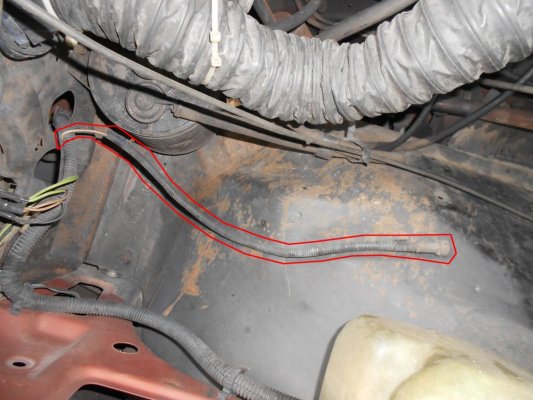We all call it a proportioning valve, but as Rick stated it is a combination valve. Two separate functions, first it will put the brake light on if you have a major fluid leak, front or back.
Well, this is interesting. Four days after I reconnected this brake-related wire, my brake warning light comes on. I haven't noticed any braking problems. What could be wrong? And what's the primary purpose of this wiring connection and valve? The emergency brake is not engaged. I've already checked that.
Rust and corrosion can put the light on over time (valve fails) without any fluid loss.
The second part of the valve "proportioning" does this:
What Does the Proportioning Valve Do for My Brakes?
Your car’s braking system is intricate and complex. There’s a lot more to braking systems than calipers and rotors. One crucial aspect of a vehicle’s braking system is the proportioning valve. Knowing the function and importance of your brake proportioning valve is essential to understanding how your car works and knowing when to get it checked out by a technician.
Function and Purpose of the Proportioning Valve
The proportioning valve typically connects the master cylinder to the rest of the braking system, but sometimes it is independent of the cylinder. This valve is necessary for optimizing front-to-rear bias, also referred to as brake balance. It is a spring-loaded component that activates when fluid pressure builds when you step on the brake pedal. Then, the valve’s plunger unseats and fluid rushes into the calibrated range. Once this happens, the spring gets compressed and the plunger blocks the fluid from passing through. Even pressure distribution among the front and rear of your vehicle is important for safe and reliable braking performance.
Advantages for Your Car
You benefit by having a brake proportioning valve in your brake system because it helps you control brake balance. Your rear brakes may receive too much pressure during rapid deceleration if the proportioning valve is not functional. A properly-working proportioning valve ensures your rear brakes do not lock-up during heavy braking. This is crucial in any car, but especially in pickup trucks with light backends.
Three Different Types of Brake Proportioning Valves
With all of this being said, it is important for you to know that there are three kinds of proportioning valves used in cars. They are:
- Master Cylinder-Mounted: These valves are located directly on the cylinder and attached to fluid ports located between the cylinder and brake lines.
- Load Sensing: These valves are located directly on the frame at the rear end of the vehicle, with a lever attaching it to the suspension system.
- Combination Valve-Mounted: These valves are part of a larger valve with the metering valve and pressure differential switch. This type of valve is usually mounted to the frame or inner fender below the master cylinder.
You might need to talk to an auto technician to determine what type of proportioning valve your vehicle has.
Signs of a Failing Proportioning Valve
Just like any other part of your car, the proportioning valve may eventually fail. There are a few different ways to tell this is happening. First, you might notice your car is taking a nose dive when you suddenly apply the brakes. Then your car may not stop fast enough. If your rear wheels lock up easily, especially when you drive on wet surfaces, it is a good sign your proportioning valve is going bad. You can also read about more signs your braking system isn’t functioning properly.
Causes of Valve Failure
If you sense your valve is failing or not operating properly, you might be wondering how this happened. Sometimes proportioning valves simply fail after a long time of driving. Other times, you might have caused the problem by making a modification that impacts your brake balance. Here are some modifications that can influence your front-to-rear bias.
Modifications that can increase front bias:
- Increased diameters of front caliper pistons
- Increased friction of front pad coefficient
- Increased diameter of front rotor
- Decreased diameters of rear caliper pistons
- Decreased friction of rear pad coefficient
- Decreased diameter of rear rotor
- Less sticky tires
- Less weight on the front axle
- A loaded rear axle
- Lowered vehicle causing a lower center of gravity
Modifications that can increase rear bias:
- Increased diameters of rear caliper pistons
- Increased friction of rear pad coefficient
- Increased diameter of rear rotor
- Decreased diameters of front caliper pistons
- Decreased friction of front pad coefficient
- Decreased diameter of front rotor
- More sticky tires
- More weight on the front axle
- An unloaded rear axle
- Raised vehicle causing a higher center of gravity


